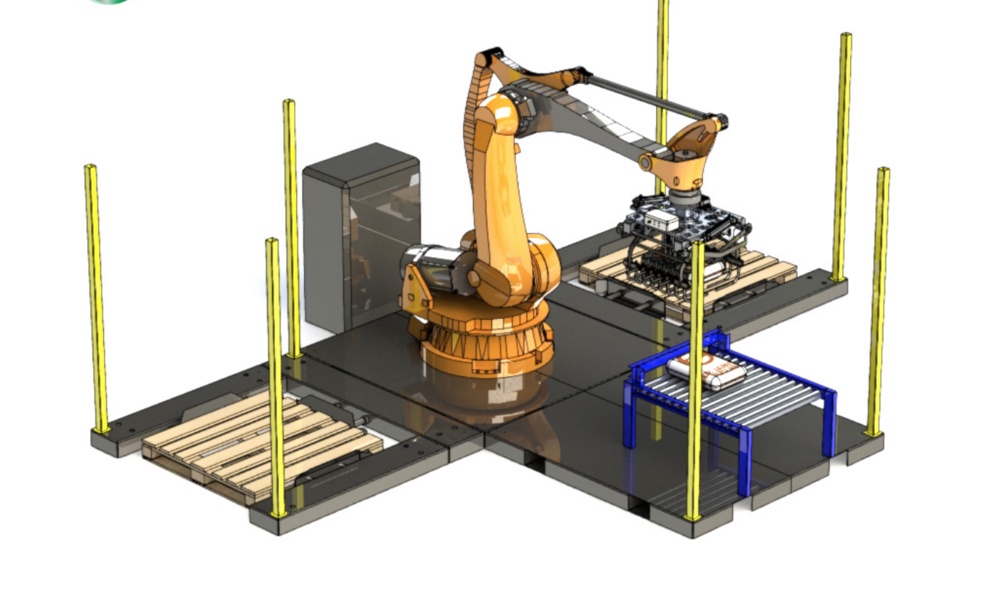How Do Robotic Palletizers Work?
Automated robotic palletizing devices load products onto pallets. They can also be set up to depalletize, which is a crucial component of many production processes. Robotic palletizing systems are able to address various problems that their more traditional counterparts, conventional palletizers, could not.
Traditional palletizers have been in use for more than 50 years. They consist of a network of conveyors and associated equipment. Before forming rows at an end stop, the product is rotated and turned as it travels down a conveyor to the correct orientation. Pallets are then used to stack the layers once the rows have been gently placed onto a layer-forming table.
An infeed conveyor is widely used by robotic palletizers, just like their conventional cousins. They don't, however, arrange things on the conveyor by bumping or sliding them. Instead, a robot moves the products by twisting them as they pass along a conveyor or by lifting them and placing them straight on a pallet.
Both traditional and robotic palletizers have advantages and disadvantages, just like any competing technologies. Conventional palletizers typically have faster cycle speeds, up to 200 cases per minute. However, they often demand more space because a network of conveyors is required to position the product.
On the other hand, robotic palletizers excel at handling high SKU counts in multi-line processes as well as manipulating the product, such as turning boxes for display purposes with labels out or stacking pails and bags. Their throughput is less consistent than that of conventional palletizers since they are frequently assigned with slower tasks like rotating items.
Benefits:
A palletizing procedure that is automated has several advantages. Most apply to both manual and automated palletizing.
• Enhanced safety
In the US, overexertion, rips, and sprains are the most frequent industrial injuries. These are typically brought on by repetitive action, moving big, heavy objects, or both. Injuries are a real possibility when goods are manually stacked and unstacked onto and off of pallets.
Giving employees enough breaks for rest, rather than just the 15 minutes required by most states, is one method to reduce this. Operators are required to fulfil their quotas, but organisations with good safety cultures will be honest about human limitations.
Avoiding putting workers in danger is another method to shield them from risk. By using robots instead of people to stack products, robotic palletizers spare people from the risks involved.
The use of equipment is another common source of injuries. The palletizing equipment is surrounded by guarding and gates to prevent this. Except for the infeed conveyor, no one is allowed to enter the robot's work area.
• Zero Damages
Robots do repetitive operations like palletizing with greater accuracy and precision than humans. Every time, they behave in accordance with their programming. They don't rush, they don't get side-tracked by loud noises from across the warehouse, and they don't mistake one SKU for another.
This prevents merchandise from being dropped, which results in less damage. It is not packed on the incorrect pallet, in the incorrect direction, or underneath a hefty object. Robots can be outfitted with end of arm tools (EOATs) that can handle just about anything, including bags, pails, cardboard boxes, hefty totes, and other objects.
• On-time Production
Robotic production is more predictable because they are both quicker and more dependable than humans. Predictability is crucial in a culture that is increasingly embracing just-in-time manufacturing and lean manufacturing principles.
A robot that performs 20 cycles per minute may work nonstop for 24 hours like a person would without taking a break. The time it will take to create enough layers to fill a single pallet or a trailer full of pallets can now be calculated precisely.
These methods clearly save money by reducing labour and its associated costs. But more than that, freeing workers from the unpleasant process of piling goods on pallets can improve the mood throughout your entire facility. Living a self-actualized existence requires you to feel as though you are on a path towards your goals and that your life has a meaning. And while there is undoubtedly nothing wrong with manual labour, few people would prefer to complete a set number of stacked boxes during their workday as opposed to more fulfilling duties.
Robotic systems have really gone through a paradigm shift in the recent years, with new advances. Not just for industrial functions but for commercial also. You can make use of these robots, like KUKA milling robots, KUKA refurbished robots, and many more specific to your precise requirements.


Comments (1)